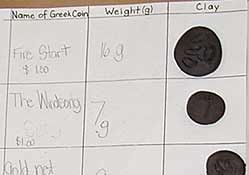

Lesson plan based on Alexander Coin
Create "ancient" clay coins to understand the ratio of weight to value, physical properties, and how ancient coins compare to contemporary coins.
Skills and Focus: Studio, Measuring, Scientific Inquiry
Subject Area: Science
Thematic Connection: Money, Connecting Past and Present
Grade Level: Elementary School
Time Needed: 90 minutes
Objectives
• Practice weighing items.
• Understand the ratio of weight to the value of ancient and modern coins.
Instructional Materials Needed
Story: Coins in the Greek World
Self-hardening clay (different colors)
Scale accurate to 0.1 g
Coins: pennies, nickels, dimes, quarters, half—dollars, and dollars

Activity
Step 1: Distribute the chart. Then have students measure clay out in grams as indicated on the chart.
Step 2: Students should strike a set of coins in clay using two modern coins to create impressions on both sides, as seen in Coins in the Greek World.
Step 3: Have students weigh each of the modern coins and record its value and weight in the chart.
Step 4: Now have students arrange the coins twice, first according to weight, and then according to value.
Critical Thinking Ask students to
• explain the weight—to—value ratio of the ancient coins.
• describe how the two coin arrangements differ.
• conclude whether the modern coins have the same weight—to—value ratio as the ancient coins.
Goals
This activity meets Illinois State Goal 13: Have a working knowledge of the relationships among science, technology, and society in historical and contemporary contexts.
|
|
|
|
| obol | 1/6 drachma | 0.7g |
| diobol | 1/3 drachma | 1.4g |
| drachma | 4.1g | |
| didrachm | 2 drachmae | 8.2g |
| tetradrachm | 4 drachmae | 16.4g |
| penny | 1/100 dollar | |
| nickel | ||
| dime | ||
| quarter | ||
| half—dollar | ||
| dollar |
© 2000, by The Art Institute of Chicago. All rights reserved. Use of this program is subject to the terms below. No part of this program may be reproduced, transmitted or distributed in any form or by any means, except for personal or classroom use. All Copyright in and to the program, in whole or in part, belongs to the publisher and its licensors and is registered with the U.S. Copyright Office